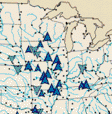
 Stream Water Quality in the Conterminous United States --
Status and Trends of Selected Indicators During the 1980's
Stream Water Quality in the Conterminous United States --
Status and Trends of Selected Indicators During the 1980's
By Richard A. Smith, Richard B. Alexander, and Kenneth J.
Lanfear
National Water Summary 1990-91 -- Stream Water Quality,
U.S. Geological Survey Water-Supply Paper 2400)
Go to Table of Contents
INTRODUCTION
In the years since enactment of the Clean Water Act, formally known as the Federal Water Pollution Control
Act Amendments of 1972 (Public Law 92-500), and its subsequent amendments in 1977, 1979, 1980, 1981,
1983, and 1987, major changes have taken place in the sources of water contaminants and in the efforts to control
them. Population distribution, land use, industrial activity, agricultural practices, and pollution-control strategies
have all changed significantly. The effects of these changes on water quality and the consequences on human and
ecological health and the use of water resources are of major economic and social importance. Thus, the early
1990's are an appropriate time to examine national water-quality conditions and trends.
In contrast to the State summaries in this volume that portray water-quality conditions and trends within
State boundaries, this article presents a summary of national water quality in the conterminous United States,
represented by the status and trends of selected indicators. This article is based on water-quality data from Federal
and State monitoring programs, generally from 1980 to 1989, and is intended to provide decisionmakers and the
public with information on the progress being made toward water-quality goals. By necessity, the analyses
presented in this article were compiled from a variety of data sources that, collectively, only partially address the
diverse water-quality issues currently of interest. The major component of this article is an analysis of U.S.
Geological Survey (USGS) monitoring data on several indicators of chemical and sanitary conditions in streams;
secondary components are analyses of U.S. Fish and Wildlife Service (FWS) finfish-tissue data and analyses of
USGS herbicide data from streams that drain agricultural areas in the Midwest.
This article is organized into three major sections, and much of the water-quality summary information is
presented graphically. Thus, the following descriptions of the sections emphasize those illustrations.
- The characteristics and limitations of existing national water-quality data.
- The water-quality data selected for analysis and the geographic characteristics of the data. Because
interpretation of water quality in the subsequent section is, in part, made on the basis of land use, this section
introduces a land-use classification that is used in this article and shown in figure 37.
- A national summary of conditions and trends in stream water quality as represented by:
- Figures 38-43, which show concentrations of six frequently measured indicators of chemical and sanitary
conditions in streams and their relation to land use,
- Figures 44-45, which show yields of nitrate, total phosphorus, and suspended sediment transported from
large water-resources regions (fig. 44) and according to land use (fig. 45),
- Figure 46, which shows water quality of tributaries to selected reservoirs,
- Figure 47, which shows loads and yields of nitrate, total phosphorus, and suspended sediment transported to
coastal waters,
- Figure 48, which shows water quality in basins used as sources of domestic, industrial, and irrigation water
uses,
- Figure 49, which shows national trends in pesticides and toxic trace elements in finfish tissue, and
- Figures 50-51, which show herbicide concentrations in streams in agricultural areas of the Midwest.
Go to next section.
National Water Summary on Wetland Resources
|
[an error occurred while processing this directive]
|
|
 Stream Water Quality in the Conterminous United States --
Status and Trends of Selected Indicators During the 1980's
Stream Water Quality in the Conterminous United States --
Status and Trends of Selected Indicators During the 1980's
 Stream Water Quality in the Conterminous United States --
Status and Trends of Selected Indicators During the 1980's
Stream Water Quality in the Conterminous United States --
Status and Trends of Selected Indicators During the 1980's